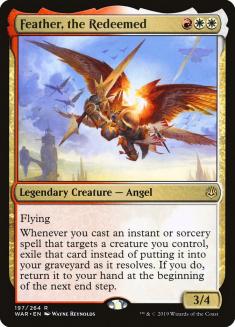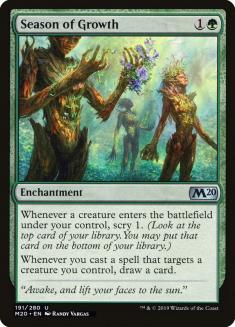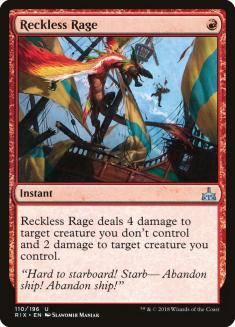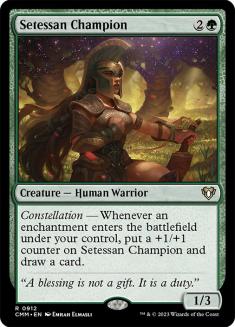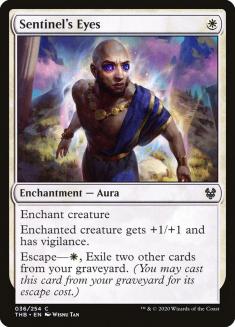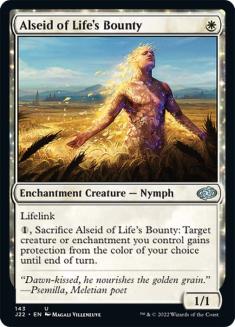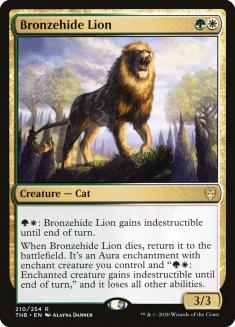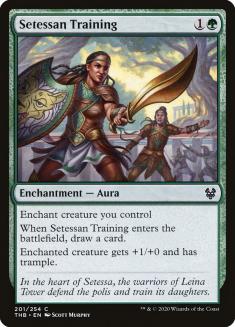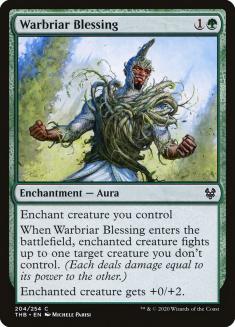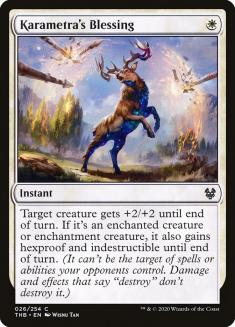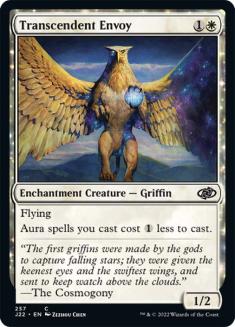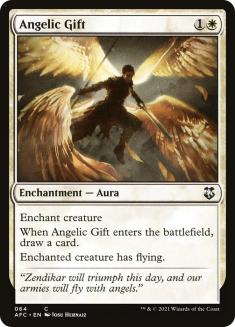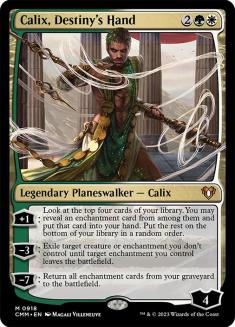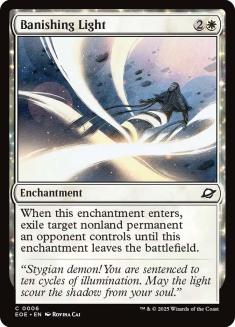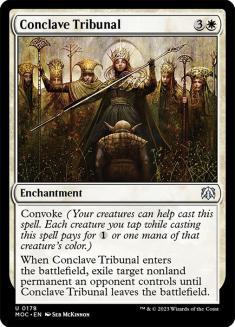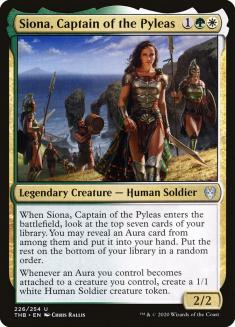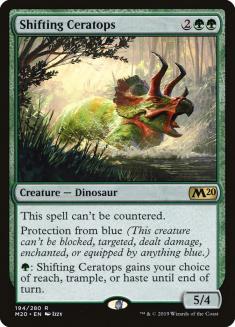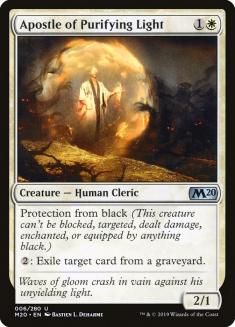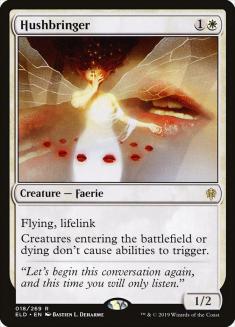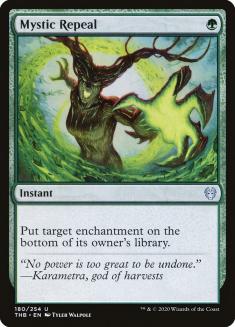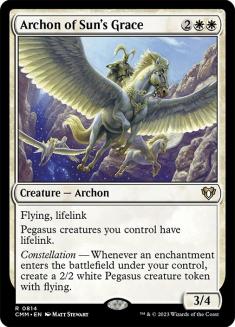Back in War of the Spark Standard, I loved the Naya Feather deck; I thought Season of Growth gave the deck an entirely new dimension and let it beat spot removal due to providing so much card advantage. With the rotation of Reckless Rage, the deck faded into obscurity; you simply weren’t getting enough value from Feather, the Redeemed, and the deck wasn’t powerful enough to justify how awkward the manabase had become.
With the release of Theros Beyond Death, we can now play a new deck with Season of Growth. Gone is the Feather angle, and in come enchantments and Auras. Here’s my latest list:
Creatures (17)
Lands (22)
Spells (21)

This deck is very straightforward. You want to play creatures and enchant them with Auras. It’s important to understand, however, that this is not a Selesnya Hexproof deck from Modern, nor does it play like one in a lot of your games. It is possible to play one creature and then stack all your Auras onto it and convert that into a win, but the good part about this deck is that you don’t need to do that. I’ve always hated the Selesnya Hexproof play pattern because it really is just putting all your eggs in one basket and if that basket is dealt with you’re done, but with Season of Growth and Setessan Champion, this deck has a surprisingly high amount of resiliency. Season of Growth in particular does a great job of finding gas over and over, since creatures can find spells via scrying and the spells draw you more creatures.
In practice, this means two things. First, you don’t need to “protect the queen” at all costs. Sometimes it’s fine to develop the battlefield and not leave up mana for Karametra’s Blessing or an Alseid of Life’s Bounty activation; if they deal with your one creature, that’s fine, you can easily recover (though sometimes of course you’re going to keep up mana to protect it — just know that it’s not necessarily a disaster if your creature is killed). The second is that you can often just spread your Auras around. Your Setessan Champion is already pretty big, so maybe you should put that All That Glitters on the Paradise Druid or the Bronzehide Lion instead. Again, sometimes you will just throw all the Auras on the same creature, but it’s not something you need to do.
What I’m Playing
The reason to play the deck. Setessan Champion is an absurdly powerful card if it lives — a lot of your enchantments are very cheap and it scales very well with anything you’re doing naturally. It’s a must-kill even if you don’t devote any other resources to it, and four copies are mandatory.
Much less obvious of an inclusion than Setessan Champion, but almost as important. This card does a lot of different things for the deck.
First, it’s a one-mana Aura, which means it draws a card off both Setessan Champion and Season of Growth. Second, it can be cast from the graveyard, and it will still trigger both these cards if you do so, which means it can kickstart you again even after you’ve lost everything. Even in a scenario where you have no cards in hand, you can draw Setessan Champion and immediately cast one or two Sentinel’s Eyes on it. Third, it can give your creatures vigilance, which is particularly important in the case of Paradise Druid. If Paradise Druid has vigilance, it effectively acts as a permanent hexproof creature, and that means it becomes the primary target for your Auras.
Alseid of Life’s Bounty also fits multiple roles in the deck. Like Sentinel’s Eyes, it’s a cheap enchantment to trigger Setessan Champion and power up All That Glitters, but it also does a good Gods Willing impression when you’re suiting up a creature. On top of that, it’s a very good Aura target against some decks, since it has lifelink — in any racing situation where they don’t have removal, it’s the one you want to enchant.
Bronzehide Lion has a solid body and a good ability in a deck that relies on keeping a creature on the battlefield to be able to enchant.
Your way of pushing through with your big creatures. You could play Angelic Gift instead (or in addition to), but when your creatures are as big as yours get with this deck, trample is just a better ability than flying. Plus, when you’re “going off,” white mana is usually more valuable than green mana.
A Prey Upon type card, except it’s also an enchantment for Setessan Champion.
At first, I thought Karametra’s Blessing was going to be incredible in the deck. After playing with it more, I think it’s good but not nearly as good as I originally imagined. The main issue is that, unless you’re enchanting an enchanted creature, you cannot protect your target if they try to kill it in response. Too many times I’ve had hands consisting of Setessan Champion and enchantments and then they kill the Champion and I’m left with a combat trick that doesn’t do anything.
Of course it still has many applications — it saves any enchanted creature for only one mana, including from sweepers, and it can protect Alseid of Life’s Bounty. It’s possible four is correct but I’ve been happy with three.
This card also has multiple applications — it’s a flying body that you can suit up, it’s a cheap enchantment, and it makes your other enchantments cheaper. That said, it’s worse than all the other two-drops, and it doesn’t work well in multiples, so I’m playing just one copy.
What I’m Not Playing
I think four copies of this effect is enough and Setessan Training is a better card in this deck.
This is an aggro deck, and your draw engine consists in playing several cheap cards in the same turn. Calix, Destiny’s Hand doesn’t really fit any of these strategies, and I think paying four mana for a situational Banishing Light is risky, even if it does do more than that in certain situations. The way I see it, if my deck is working then Calix isn’t needed, and if it’s not working then Calix is not going to save me.
Banishing Light and other similar effects are too reactive for a deck like this. Basically, the way I see it, your deck is split between two types of cards, creatures and Auras, and you need to draw a healthy mix of both to win (you certainly need at least one of each). For a card to be in the deck when it’s neither of these things it has to be really good (like Season of Growth, which makes assembling your combos much easier), and a Banishing Light-type card isn’t that.
The way your deck works, you need to get a creature on the battlefield and then you can start playing the game. If your creature costs three, you only start playing the game on Turn 4, and I think that’s too late for what you gain out of this card — Setessan Champion gets away with it because it’s powerful enough to make up for the lost time, but Siona isn’t.
The Sideboard
You need to be careful while sideboarding with this deck, because you always need to keep a reasonable number of both creatures and Auras in it. For this reason, a lot of the cards in the sideboard are creatures, so they can do double duty and you can keep your creature count relatively similar even if you need to take out creatures.
Very good versus any mono-blue deck, but I also like it versus Azorius and Esper. It’s not an ultimate trump in these matchups, since they will have ways of dealing with them, but it still kills planeswalkers and is overall a hard card for them to deal with.
An unkillable and unblockable creature for you to suit up against mono-black decks, this also happens to have graveyard hate built in for cards like Cauldron Familiar. I expect we’ll see more of this card, even outside of an Auras deck.
This is your best card against Elementals, as it stops Risen Reef; Omnath, Locus of the Roil; and Cavalier of Thorns. Basically, if people are playing Thassa, Deep-Dweller to reset their enters-the-battlefield abilities, you want Hushbringer to stop them. It also stops Nightmare Shepherd and Gray Merchant of Asphodel, so it’s a good card versus Mono-Black Devotion as well if they are running these two cards.
A good card in the mirror and also versus Banishing Light decks and Jeskai Fires. Normally I don’t like bringing in cards like this versus Fires of Invention builds, since you spend your turn dealing with a card that effectively cost zero, but I think in this deck it’s correct, since it’s a very cheap card that doesn’t waste your whole turn and you have nothing else to bring anyway.
This is your “plan B” against decks that don’t have removal. If they can’t kill it, then it’s powerful enough to win the game on its own.
If you like this sort of playstyle, you should give this deck a try. It draws more cards than any blue deck in the format and it’s way more resilient than people give it credit for.


